ZHCSDD3 December 2014 DRV5053-Q1
PRODUCTION DATA.
- 1 特性
- 2 应用
- 3 说明
- 4 输出状态
- 5 修订历史记录
- 6 Pin Configuration and Functions
- 7 Specifications
- 8 Detailed Description
- 9 Application and Implementation
- 10Power Supply Recommendations
- 11器件和文档支持
- 12机械封装和可订购信息
7 Specifications
7.1 Absolute Maximum Ratings
over operating free-air temperature range (unless otherwise noted)(1)| MIN | MAX | UNIT | ||
|---|---|---|---|---|
| Power supply voltage | VCC | –22(2) | 40 | V |
| Voltage ramp rate (VCC), VCC < 5 V | Unlimited | V/µs | ||
| Voltage ramp rate (VCC), VCC > 5 V | 0 | 2 | ||
| Output pin voltage | OUT | –0.5 | 2.5 | V |
| Output pin reverse current during reverse supply condition | OUT | 0 | –20 | mA |
| Operating junction temperature, TJ | Q, see Figure 17 | –40 | 150(3) | °C |
| E, see Figure 17 | –40 | 175(4) | ||
| Tstg | Storage temperature range | –65 | 150 | °C |
(1) Stresses beyond those listed under Absolute Maximum Ratings may cause permanent damage to the device. These are stress ratings only, which do not imply functional operation of the device at these or any other conditions beyond those indicated under Recommended Operating Conditions. Exposure to absolute-maximum-rated conditions for extended periods may affect device reliability.
(2) Ensured by design. Only tested to –20 V.
(3) Tested in production to TA = 125°C.
(4) Tested in production to TA = 150°C.
7.2 ESD Ratings
| VALUE | UNIT | |||
|---|---|---|---|---|
| V(ESD) | Electrostatic discharge | Human body model (HBM), per ANSI/ESDA/JEDEC JS-001, all pins(1) | ±2500 | V |
| Charged device model (CDM), per JEDEC specification JESD22-C101, all pins(2) | ±500 | |||
(1) JEDEC document JEP155 states that 500-V HBM allows safe manufacturing with a standard ESD control process.
(2) JEDEC document JEP157 states that 250-V CDM allows safe manufacturing with a standard ESD control process.
7.3 Recommended Operating Conditions
over operating free-air temperature range (unless otherwise noted)| MIN | MAX | UNIT | |||
|---|---|---|---|---|---|
| VCC | Power supply voltage | 2.7 | 38 | V | |
| VOUT | Output pin voltage (OUT) | 0 | 2 | V | |
| ISOURCE | Output pin current source (OUT) | 0 | 300 | µA | |
| ISINK | Output pin current sink (OUT) | 0 | 2.3 | mA | |
| TA | Operating ambient temperature | Q, see Figure 17 | –40 | 125 | °C |
| E, see Figure 17 | –40 | 150 | |||
7.4 Thermal Information
| THERMAL METRIC(1) | DRV5053-Q1 | UNIT | ||
|---|---|---|---|---|
| DBZ | LPG | |||
| 3 PINS | 3 PINS | |||
| RθJA | Junction-to-ambient thermal resistance | 333.2 | 180 | °C/W |
| RθJC(top) | Junction-to-case (top) thermal resistance | 99.9 | 98.6 | |
| RθJB | Junction-to-board thermal resistance | 66.9 | 154.9 | |
| ψJT | Junction-to-top characterization parameter | 4.9 | 40 | |
| ψJB | Junction-to-board characterization parameter | 65.2 | 154.9 | |
(1) For more information about traditional and new thermal metrics, see the IC Package Thermal Metrics application report, SPRA953.
7.5 Electrical Characteristics
over operating free-air temperature range (unless otherwise noted)| PARAMETER | TEST CONDITIONS | MIN | TYP | MAX | UNIT | |
|---|---|---|---|---|---|---|
| POWER SUPPLIES (VCC) | ||||||
| VCC | VCC operating voltage | 2.7 | 38 | V | ||
| ICC | Operating supply current | VCC = 2.7 to 38 V, TA = 25°C | 2.7 | mA | ||
| VCC = 2.7 to 38 V, TA = TA, MAX(1) | 3 | 3.6 | ||||
| ton | Power-on time | 35 | 50 | µs | ||
| PROTECTION CIRCUITS | ||||||
| VCCR | Reverse supply voltage | –22 | V | |||
| IOCP,SOURCE | Overcurrent protection level | Sourcing current | 300 | µA | ||
| IOCP,SINK | Overcurrent protection level | Sinking current | 2.3 | mA | ||
(1) TA, MAX is 125°C for Q Grade 1 devices and 150°C for E Grade 0 devices (see Figure 17)
7.6 Switching Characteristics
over operating free-air temperature range (unless otherwise noted)| PARAMETER | TEST CONDITIONS | MIN | TYP | MAX | UNIT | |
|---|---|---|---|---|---|---|
| ANALOG OUTPUT (OUT) | ||||||
| td | Output delay time | TA = 25°C | 13 | 25 | µs | |
7.7 Magnetic Characteristics
over operating free-air temperature range (unless otherwise noted)| PARAMETER | TEST CONDITIONS | MIN | TYP | MAX | UNIT(2) | |
|---|---|---|---|---|---|---|
| VQ | Quiescent output | B = 0 mT |
0.9 | 1.02 | 1.15 | V |
| ƒBW | Bandwidth(3) | 20 | kHz | |||
| BN | Input-referred noise(1) | COUT = 50 pF |
0.40 | 0.58 | 0.79 | mTpp |
| Le | Linearity(4) | –BSAT < B < BSAT | 1% | |||
| VOUT MIN | Output saturation voltage (min) | B < –BSAT | 0.2 | V | ||
| VOUT MAX | Output saturation voltage (max) | B > BSAT | 1.8 | V | ||
| DRV5053OA: –11 mV/mT | ||||||
| S | Sensitivity | VCC = 3.3 V |
–17.5 | –11 | –5 | mV/mT |
| VN | Output-referred noise(1) | VCC = 3.3 V; ROUT = 10 kΩ; COUT = 50 pF |
6 | mVpp | ||
| BSAT | Input saturation field | VCC = 3.3 V |
73 | mT | ||
| DRV5053PA: –23 mV/mT | ||||||
| S | Sensitivity | VCC = 3.3 V |
–35 | –23 | –10 | mV/mT |
| VN | Output-referred noise(1) | VCC = 3.3 V; ROUT = 10 kΩ; COUT = 50 pF |
13 | mVpp | ||
| BSAT | Input saturation field | VCC = 3.3 V |
35 | mT | ||
| DRV5053RA: –45 mV/mT | ||||||
| S | Sensitivity | VCC = 3.3 V |
–70 | –45 | –20 | mV/mT |
| VN | Output-referred noise(1) | VCC = 3.3 V; ROUT = 10 kΩ; COUT = 50 pF |
26 | mVpp | ||
| BSAT | Input saturation field | VCC = 3.3 V |
18 | mT | ||
| DRV5053VA: –90 mV/mT | ||||||
| S | Sensitivity | VCC = 3.3 V |
–140 | –90 | –45 | mV/mT |
| VN | Output-referred noise(1) | VCC = 3.3 V; ROUT = 10 kΩ; COUT = 50 pF |
52 | mVpp | ||
| BSAT | Input saturation field | VCC = 3.3 V |
9 | mT | ||
| DRV5053CA: 23 mV/mT | ||||||
| S | Sensitivity | VCC = 3.3 V |
10 | 23 | 35 | mV/mT |
| VN | Output-referred noise(1) | VCC = 3.3 V; ROUT = 10 kΩ; COUT = 50 pF |
13 | mVpp | ||
| BSAT | Input saturation field | VCC = 3.3 V |
35 | mT | ||
| DRV5053EA: 45 mV/mT | ||||||
| S | Sensitivity | VCC = 3.3 V |
20 | 45 | 70 | mV/mT |
| VN | Output-referred noise(1) | VCC = 3.3 V; ROUT = 10 kΩ; COUT = 50 pF |
26 | mVpp | ||
| BSAT | Input saturation field | VCC = 3.3 V |
18 | mT | ||
(1) Not tested in production; limits are based on characterization data.
(2) 1 mT = 10 Gauss
(3) Bandwidth describes the fastest changing magnetic field that can be detected and translated to the output.
(4) Linearity describes the change in sensitivity across the B-range. The sensitivity near BSAT is typically within 1% of the sensitivity near
B = 0.
B = 0.
7.8 Typical Characteristics
TA > 125°C data is valid for Grade 0 devices only (E, see Figure 17)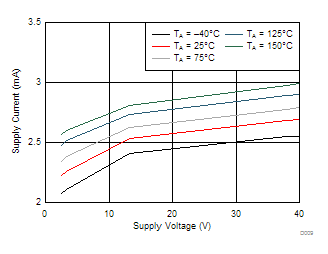
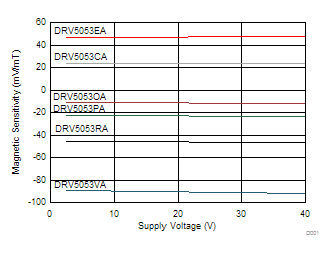
| TA = 25°C | ||
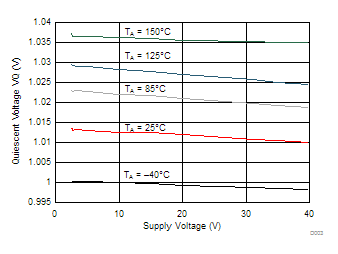
| TA = 25°C |
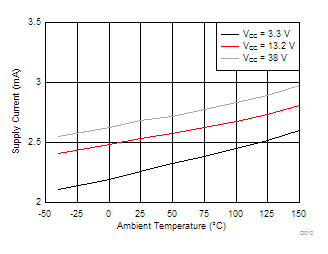
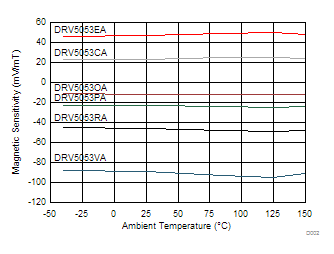
| VCC = 3.3 V | ||
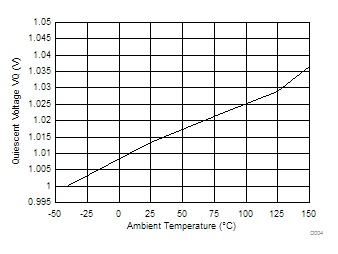
| VCC = 3.3 V |